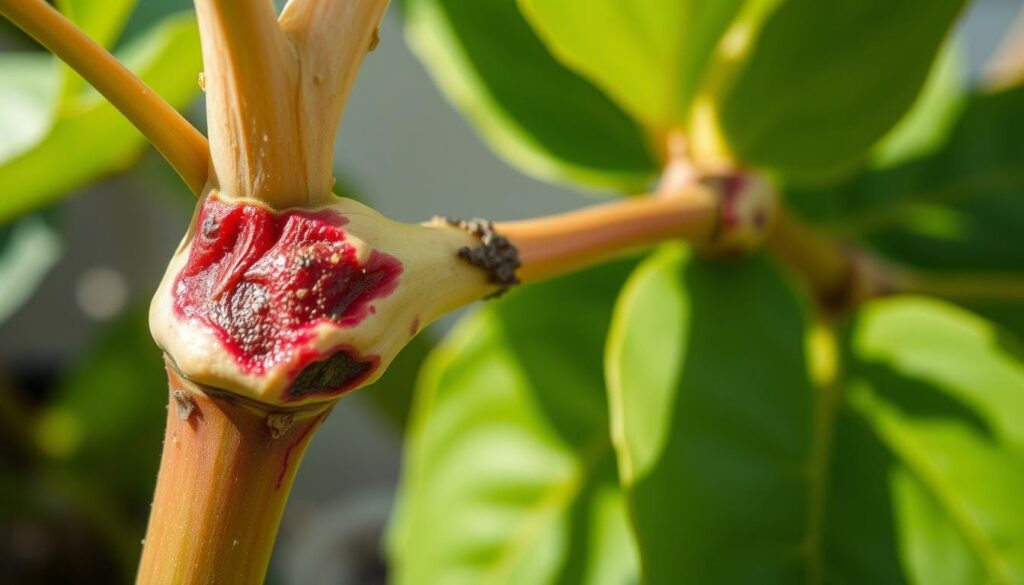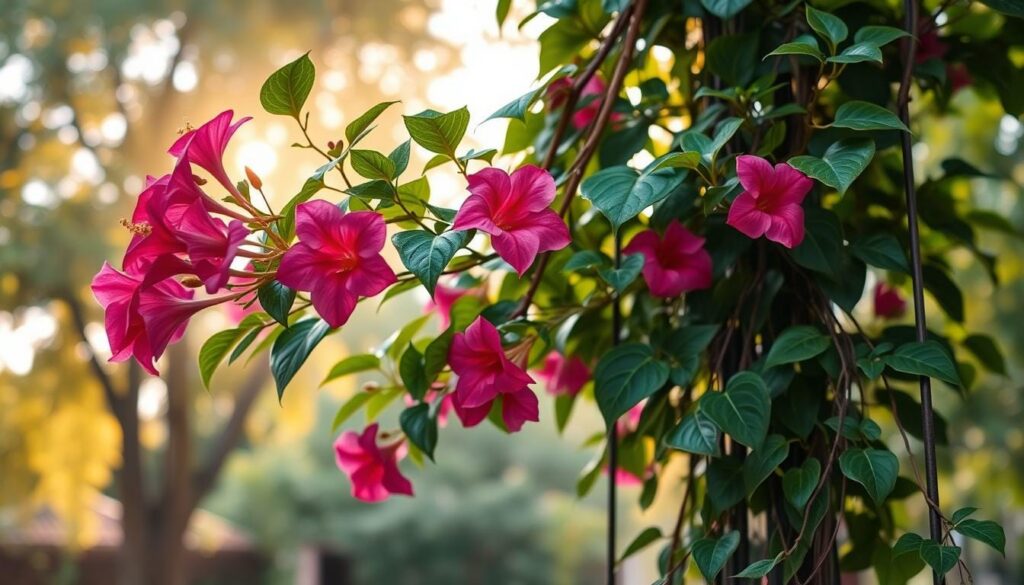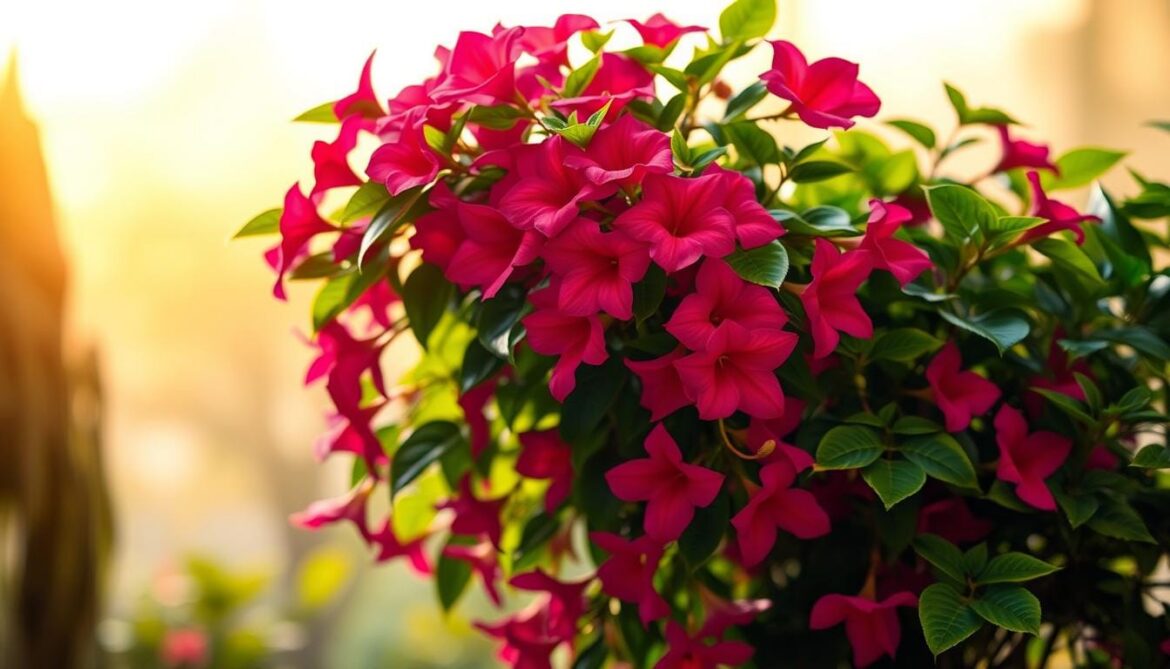As a passionate gardener, I’ve learned that Mandevilla vines can be both a joy and a challenge. These tropical beauties with vibrant trumpet-shaped flowers can fall victim to various diseases. These diseases threaten their lush appearance and robust growth.
Tropical gardeners know the delicate balance needed to keep these stunning plants healthy. Mandevilla plant disease prevention starts with understanding their unique environmental needs.
Mandevilla plants thrive in USDA hardiness zones 8-11. They need specific care to stay healthy. From root rot to pest infestations, these plants face many challenges. These challenges can impact their stunning bloom.
Key Takeaways
- Mandevilla requires 6-8 hours of direct sunlight daily
- Optimal temperature range is 68-90 degrees Fahrenheit
- Soil pH should be between 6.6 and 7.8
- Regular pruning helps maintain plant health
- Watch for early signs of pest and disease symptoms
Introduction to Mandevilla Plant Diseases
Mandevilla plants are stunning tropical climbers that add vibrant colors to gardens in the United States. Despite their strong nature, these plants can face various diseases. These diseases can harm their health and growth.
It’s important for gardeners to know about these threats. With about 100 species mainly in tropical America, Mandevillas face several health challenges. These challenges can affect their blooms and overall health.
“Knowing your plant’s weaknesses is the first step in keeping it healthy and beautiful.”
The common threats to Mandevilla plants include:
- Fungal infections
- Bacterial diseases
- Mandevilla plant pests
- Environmental stress factors
Gardeners need to know that these plants need special care to avoid disease. Optimal growing conditions are key to keeping plants healthy. With the right temperature (68°F to 90°F) and care, Mandevillas can fight off many diseases.
Signs of disease include discoloration, leaf drop, stunted growth, and fewer flowers. Spotting these signs early and acting fast is vital. This way, your Mandevilla can stay healthy and keep blooming all season.
Identifying Symptoms of Mandevilla Plant Diseases
It’s important to spot disease signs early in Mandevilla plants. This helps keep them healthy and stops damage. Owners should watch for signs of fungal or bacterial diseases.
Disease symptoms can show up in different ways. This makes it hard for gardeners. Knowing these signs helps gardeners act fast and save their plants.
Discoloration and Leaf Drop
Yellow leaves are a big warning sign. Look out for:
- Yellow leaves that mean the plant needs more nutrients
- Brown or tan spots on leaf veins
- Leaves falling off too early
- Fuzzy white growth that means a fungal infection
Wilting and Stunted Growth
Wilting and slow growth are serious signs. Watch for:
- Leaves that droop even when watered well
- A plant that doesn’t grow as it should
- Leaves that grow too long because of too little light
- Problems with the roots
Blossom Drop and Poor Bloom Quality
Flower problems show the plant is stressed. Look for:
- Flowers falling off too soon
- Not enough flowers
- Flowers that are discolored or deformed
- Not as many vibrant flowers as expected
| Symptom | Potential Cause | Recommended Action |
|---|---|---|
| Yellowing Leaves | Nutrient Deficiency | Balanced Fertilization |
| Wilting | Root Stress | Adjust Watering Practices |
| White Powdery Spots | Fungal Infection | Fungicide Treatment |
Acting fast and treating the right way can help your Mandevilla get better. It can also keep it healthy for a long time.
Fungal Diseases Affecting Mandevilla
Mandevilla plants can get sick from fungal infections. These diseases can harm their health and beauty. Knowing about these diseases helps gardeners keep their plants safe.
Fungal diseases can hit mandevilla plants fast. It’s important to spot symptoms early. This helps manage and prevent the problem.
Powdery Mildew: A Silent Threat
Powdery mildew looks like a white dust on mandevilla leaves. It loves humid weather. This fungus makes a film that blocks sunlight and harms the plant.
- Causes reduced plant vigor
- Spreads rapidly in warm, humid environments
- Can lead to leaf distortion and premature leaf drop
Root Rot: Underground Destruction
Root rot is a big problem for mandevilla plants. It happens when there’s too much water and poor drainage. This disease attacks the roots, stopping the plant from getting nutrients.
- Symptoms include wilting and yellowing leaves
- Roots become mushy and dark brown
- Often results from overwatering or inadequate soil drainage
Leaf Spot Diseases: Visual Warning Signs
Leaf spot diseases show up as marks on mandevilla leaves. Anthracnose is a common one. It makes tan to brown spots that spread fast.
- Brown or black circular spots appear on leaves
- Spots may have yellow halos
- Severe infections can cause complete leaf drop
Prevention is always better than cure when managing diseases of mandevilla plant.
To avoid fungal problems, take good care of your plants. Make sure they have enough air and don’t get too wet.
Bacterial Infections in Mandevilla
Bacterial diseases can harm Mandevilla plants a lot. They can damage the plant’s health and look. These infections spread fast and can make it hard for the plant to grow well.

Researchers have found important things about mandevilla plant bacterial diseases. Gardeners need to know these:
- Bacterial infections can develop quickly
- Symptoms may resemble fungal disease patterns
- Early detection is key for the plant’s survival
Bacterial Leaf Spot in Mandevilla
Bacterial leaf spot is a common disease in Mandevilla plants. It was first seen in 2008. Pseudomonas savastanoi strains cause it, making big spots on leaves with chlorotic rings.
Here are the main signs of bacterial leaf spot:
- Water-soaked lesions on leaves
- Brown or black spot development
- Potential spread to other plant tissues
Soft Rot in Mandevilla Roots
Root soft rot is another big problem for Mandevilla plants. It attacks the roots, causing them to decay. This can make the plant fall apart. The disease starts in the roots and then spreads up.
To stop bacterial infections, you need to take care:
- Avoid overhead irrigation
- Maintain proper plant spacing
- Use clean, sterilized gardening tools
- Watch plants closely for early signs of infection
Being careful and proactive is the best way to fight bacterial diseases in Mandevilla plants.
Pest-Related Issues in Mandevilla
Mandevilla plants face many pests that harm their health and beauty. Plants kept indoors over winter are more at risk. These pests can quickly weaken the plant.
It’s important to know about common mandevilla pests. These tiny bugs can do a lot of damage if not stopped.
Identifying Aphid Infestations
Aphids are small, soft insects that harm mandevilla plants a lot. They can cause big problems:
- Make new leaves look distorted and yellow
- Cover the plant in sooty mould
- Can spread viral diseases
Spider Mite Damage Detection
Spider mites are tiny pests that can harm your mandevilla. Look out for these signs:
- Yellow spots or bronzing on leaves
- Distorted flower and leaf buds
- Fine webs in heavy infestations
Spotting them early is key. If over 25% of leaves are damaged, act fast. Use organic pyrethrum-based insecticides and keep plants clean.
Watching closely and acting quickly can stop pests from taking over your mandevilla plants.
Environmental Factors Contributing to Disease
Mandevilla plants face many challenges from their environment. Knowing how these conditions affect them is vital. It helps keep these plants healthy and vibrant.

These tropical plants are very sensitive to their surroundings. Certain environmental factors can make them more prone to diseases and stress.
Water and Drainage Challenges
Getting the watering right is critical for mandevilla plants. They need the right amount of moisture:
- Too much water causes root rot
- Bad drainage leads to fungal growth
- The soil should be moist but not soggy
Humidity and Temperature Dynamics
Mandevilla plants do best in certain conditions. Temperature and humidity are very important for their health.
- They prefer temperatures between 60-80°F
- Temperatures under 50°F can stress them out
- High humidity helps them grow well
Gardeners need to watch these factors closely. This helps avoid diseases and keeps mandevilla plants strong. A stable environment is essential for their health.
Nutrient Deficiencies and Plant Health
Keeping your mandevilla plant well-nourished is key to avoiding nutrient deficiencies and diseases. Knowing how nutrients affect plant health helps gardeners keep their mandevillas looking great.
Nutrient shortages can harm your mandevilla’s health and strength. These issues show up in specific ways that gardeners need to watch for.
Nitrogen Deficiency: Recognizing the Signs
Nitrogen is vital for plant growth. Without enough nitrogen, mandevillas show clear signs:
- Yellowing of older leaves, starting from the bottom of the plant
- Stunted overall growth
- Reduced leaf size and vigor
- Pale green to yellow coloration throughout the plant
Phosphorus Deficiency: Impact on Plant Performance
Phosphorus helps with root growth and flowers in mandevillas. Look for these signs of phosphorus shortage:
- Reduced bloom production
- Purplish discoloration of leaves
- Weak root systems
- Decreased overall plant energy
To avoid nutrient shortages, gardeners should feed plants every two weeks with a balanced, slow-release fertilizer. Use a fertilizer with an N-P-K ratio of 5-10-10 during the growing season. Stop fertilizing from fall to early spring if you’re keeping plants indoors.
Proper nutrition is the key to preventing mandevilla plant diseases and maintaining robust, blooming plants.
Managing Mandevilla Plant Diseases
To keep your mandevilla plant healthy, you need a plan. This plan should include prevention, watching for signs, and acting fast when needed. Knowing what your plant needs and what might harm it is key.
Start by making your plant’s home less welcoming to diseases. With the right steps, you can lower the chance of your mandevilla getting sick.
Cultural Practices for Disease Prevention
To stop diseases, focus on a few important things:
- Make sure plants have enough space for air to move around
- Keep the soil moist but not too wet
- Clear up any leaves or debris near the plant
- Trim off any sick parts right away
- Clean your tools well after each use
Chemical Treatments and Fungicides
If your mandevilla does get sick, using the right chemicals can help. Here are some good options:
- Pageant for strong fungal protection
- Daconil for spots and blight on leaves
- Spectro 90WDG for fighting many diseases
- Protect to stop fungal infections before they start
Organic Solutions for Disease Management
If you prefer natural ways to fight plant diseases, there are options:
- Neem oil for pests and fungi
- Copper-based organic fungicides
- Biological control agents
- Compost tea to boost plant health
Using these methods together can help keep your mandevilla plant safe. This way, your plant will stay healthy and beautiful all season.
Best Practices for Healthy Mandevilla Growth
To grow a healthy mandevilla plant, you need to care for it well. Knowing what your plant needs is the first step. By following key practices, you can help your mandevilla stay healthy and avoid diseases.
There are a few important things to keep in mind for your plant’s health:
- Select well-draining soil mixtures
- Implement proper pruning techniques
- Establish consistent watering schedules
Creating the Perfect Soil Environment
The right soil is key for a healthy mandevilla. A good mix includes:
| Ingredient | Proportion |
|---|---|
| Potting Mix | 2 parts |
| Sand | 1 part |
| Compost | 1 part |
Pruning for Optimal Growth
Pruning is vital for your plant’s health. Strategic trimming makes your plant bushier and keeps diseases away. Cut off any dead or sick branches to stop infections from spreading.
Mastering the Watering Schedule
Watering is also important for keeping your mandevilla healthy. Here’s what experts suggest:
- Water thoroughly once or twice weekly
- Avoid daily shallow watering
- Ensure proper drainage to prevent root rot
By following these tips, you can help your mandevilla stay strong against diseases. This will lead to beautiful and healthy growth.
Conclusion: Keeping Your Mandevilla Healthy
To keep your Mandevilla plant healthy, you need to care for it well and act fast when problems arise. Knowing what these plants need helps you avoid diseases. Regular checks and quick action are essential for their growth and beauty.
For the best care, make sure your Mandevilla gets enough sunlight, drains well, and stays at a steady temperature. Experts say to keep it between 60-70 degrees Fahrenheit. Also, protect it from frost, as it can harm these plants a lot. Prune in spring and feed it well to boost its health.
Preventive steps like good air flow, not too much water, and right fertilization help a lot. Remember, Mandevillas do best with consistent care. Keep an eye out for any signs of trouble and act fast.
Your Mandevilla’s health is all about knowing what it needs and giving it the right environment. With careful attention and quick action, you can enjoy its beautiful blooms and green leaves all season.

